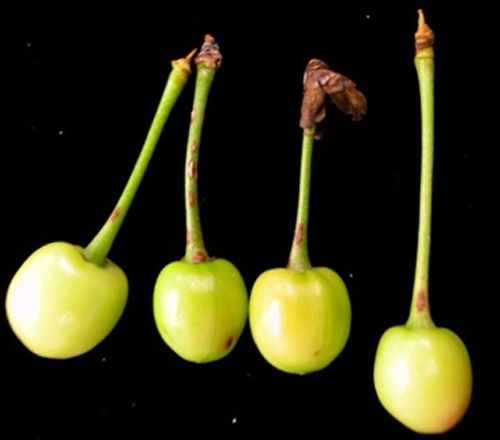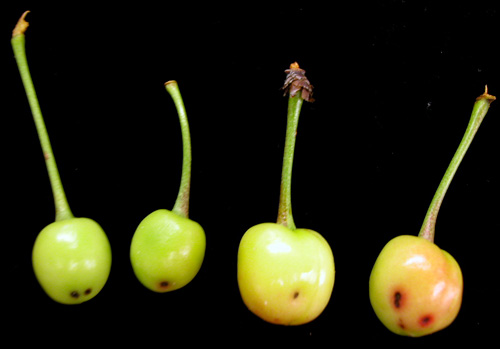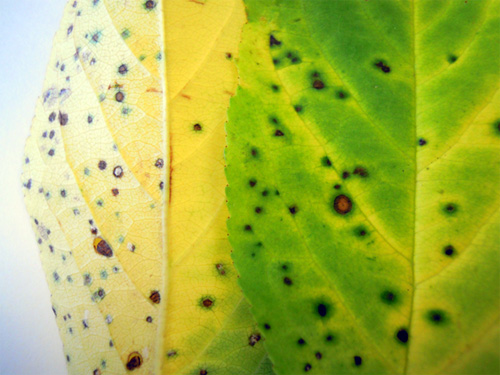Cherry leaf spot and tart cherries prior to harvest
Early cherry leaf spot infections increase the risk of epidemic infection levels in the north.
We have observed significant cherry leaf spot infections early this season and defoliation from this disease is underway in some blocks. Leaf loss appears particularly high in blocks that had early foliar bacterial canker infections. Growers should look closely to determine if it is cherry leaf spot, bacterial canker, virus or phytotoxicity that is causing defoliation in their blocks (see Several potential causes for leaf loss in tart cherry article).
Cherry leaf spot forms small, purple spots that first appear on the upper surface of leaves; white to pink spore masses develop during wet weather on the undersides of the spots (photo 1). These white spore masses on the underside of the leaf are one of the major identifying characteristics that will not be present with other potential causes of defoliation like bacterial canker or phytotoxicity.
Photo 1. Symptoms of cherry leaf spot on the lower and upper leaf surface of Montmorency. Photo credit: E. Lizotte, MSUE.
The cherry leaf spot lesions turn brown and often fall out, causing a shot-hole effect. Cherry leaf spot is primarily a disease of tart cherry, but we have observed lesions in sweet cherry this season. Because of the intense disease pressure this season, blocks that did not receive adequate control have pedicel infections (photo 2), and fruit infection (photo 3) is possible.

Photo 2. Symptoms of cherry leaf spot on pedicels of Montmorency. Photo credit: G. Sundin, MSUE.

Photo 3. Symptoms of cherry leaf spot on fruit of Montmorency. Photo credit: G. Sundin, MSUE.
With the current inoculum loads in orchards, disease pressure is high and will continue to drive the cherry leaf spot epidemic for the rest of the season. Even if cherry leaf spot infection has been kept in check thus far, continued control should be maintained to keep orchards clean. Pristine + Captan, Gem + Captan, Adamant + Captan, copper formulations (1.2 lb actual Cu/A), and Syllit + Captan are all excellent cover applications for cherry leaf spot control; remember to check the pre-harvest interval on these materials as harvest approaches. Sterol inhibitors, such as Indar, Orbit or Elite, that are being applied for American brown rot management will not provide control of cherry leaf spot. A minimum of one and possibly two post-harvest applications for leaf spot will be necessary in blocks with significant current cherry leaf spot symptoms.
With the potential of cherry leaf spot and from what we have observed so far this season, full cover, post-harvest, chlorothalonil applications at 10-day intervals or one-half side applications at seven-day intervals are recommended. Spores of this fungus are dispersed from leaf to leaf by rainfall, so if we continue to see dry weather, the potential for cherry leaf spot infection will decrease and management programs may be adjusted accordingly in low pressure sites (high pressure sites should remain more conservative in their practices regardless of weather).
Trees need to retain a minimum of 50 percent of their leaves through the end of September in order to maintain winter hardiness. However, leaf losses of 50 percent or more can impact fruit quality and yield in subsequent years. The bottom line is the more leaves on the tree as they move into winter, the better overall tree health. Growers should be sure to read pesticide labels and follow the manufacturer’s directions.
Dr. Sundin's work is funded in part by MSU's AgBioResearch.



 Print
Print Email
Email

